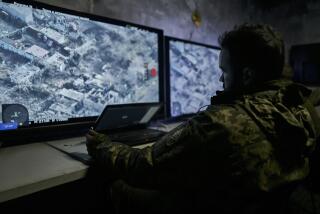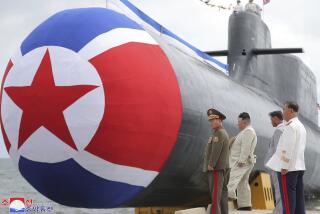Russia Gives Up All Hope on Sub
- Share via
MOSCOW — Russian authorities abandoned hope Saturday of finding any survivors among seven missing crew members of a nuclear-powered submarine that sank before dawn as it was being towed to a scrap yard.
One survivor was plucked from the Barents Sea soon after the accident, and two bodies were recovered. There is no likelihood of finding additional survivors, Defense Minister Sergei B. Ivanov told reporters after arriving in Severomorsk, the main base of Russia’s Northern Fleet.
“The sub went to the bottom ... with an open deckhouse,” Ivanov said, which meant seawater would have flooded the vessel. “It is impossible to find any of the remaining seven crew members alive.”
Adm. Viktor Kravchenko, the Russian navy’s chief of staff, said earlier that the sea was so cold that any crew members who made it out of the sinking vessel could not have survived for more than 40 minutes.
“While listening to the hull of the submarine with the rescue vessel’s equipment, there were no sounds coming from inside,” Kravchenko said.
Officials said there were no weapons aboard the submarine, which was decommissioned in 1989, and insisted that the on-board nuclear reactors presented no safety or environmental risks.
Russia’s last major submarine accident was the sinking of the Kursk on Aug. 12, 2000, after a torpedo exploded on board. That disaster, also in the Barents Sea, took the lives of all 118 crew members. Twenty-three of those men survived in the sunken vessel for hours, perhaps longer, waiting to be rescued.
Although bad weather played a role in Saturday’s sinking of the K-159 submarine, Ivanov placed primary blame on those involved in the towing operation.
The 1960s-era attack submarine was being towed on four pontoons from its base in the town of Gremikha to a dismantling plant in Polyarnyy, nearly 200 miles to the northwest. The pontoons tore off in a storm and the submarine sank in 560 feet of water, the Defense Ministry said. It went down about 3 1/2 miles off Kildin island.
Ivanov said he had been informed that “all the imaginable safety rules were broken during the towing,” and cited a poor job of fastening the vessel to the pontoons.
“Technical standards of towing were ignored during the voyage, and there was no prompt reaction to the severance of the submarine from the tugboat,” he said.
The crew was warned to abandon the submarine 40 minutes before it sank, the Interfax news agency reported, quoting a Northern Fleet spokesman. But the K-159 was one of two nuclear submarines being towed at the time, and the presence of the second vessel confused rescuers, the agency reported.
Ivanov said that Sergei Zhemchuzhny, commander of the submarine unit based in Gremikha, was being relieved of his duties pending investigation. “I’m not a judge,” Ivanov said. “A court will determine who is guilty of the tragedy.”
He pointedly added that he supported suspension of the commander. “The investigation will be conducted very thoroughly and scrupulously, and it has begun,” Ivanov said.
President Vladimir V. Putin was on board the Russian missile cruiser Moskva off the coast of Sardinia, accompanied by Italian Prime Minister Silvio Berlusconi, during a summit.
“The tragedy in the Barents Sea once again brings out the fact that seagoing requires discipline, that the sea doesn’t forgive mistakes,” Putin told the ship’s crew. “There will be a thorough investigation of the wreckage.”
At the time of the Kursk tragedy, Putin was on holiday and drew criticism that he did not respond quickly enough to the disaster.
The K-159 is smaller than the Kursk, so it is practical to raise it from the seabed to scrap it properly, Ivanov said.
Because the submarine’s two nuclear reactors were shut down when the vessel was decommissioned in 1989, the nuclear materials on board pose no environmental threat, authorities said.
The Norwegian environmental group Bellona, however, questioned that assumption.
“It is clear that the old reactor of the submarine is not waterproof, as it should be,” said Igor Kudrik, an expert with Bellona, which has long studied Russia’s nuclear arsenal. “So to our mind, the radiation leaks started right after the vessel sank.”
About 140 decommissioned Russian nuclear submarines are still awaiting dismantling, and “such incidents cannot be excluded in the future,” Kudrik said.
Russia has announced plans to destroy about 130 submarines by 2010, at a projected cost of $3.9 billion. The United States and other countries, including Japan, have contributed or pledged funds for the effort, but the process is proceeding slowly.
*
Yakov Ryzhak of The Times’ Moscow Bureau contributed to this report.
More to Read
Sign up for Essential California
The most important California stories and recommendations in your inbox every morning.
You may occasionally receive promotional content from the Los Angeles Times.













